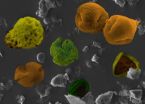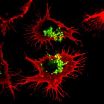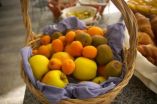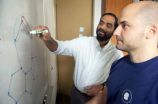Researchers at MIT, Virginia Tech and Princeton University analyzed the way domestic and big cats lap and found that felines of all sizes take advantage of a perfect balance between two physical forces. The results will be published in the November 11 online issue of the journal Science.
It was known that when they lap, cats extend their tongues straight down toward the bowl with the tip of the tongue curled backwards like a capital "J" to form a ladle, so that the top surface of the tongue actually touches the liquid first. We know this because another MIT engineer, the renowned Doc Edgerton, who first used strobe lights in photography to stop action, filmed a domestic cat lapping milk in 1940.
But recent high-speed videos made by this team clearly revealed that the top surface of the cat's tongue is the only surface to touch the liquid. Cats, unlike dogs, aren't dipping their tongues into the liquid like ladles after all. Instead, the cat's lapping mechanism is far more subtle and elegant. The smooth tip of the tongue barely brushes the surface of the liquid before the cat rapidly draws its tongue back up. As it does so, a column of milk forms between the moving tongue and the liquid's surface. The cat then closes its mouth, pinching off the top of the column for a nice drink, while keeping its chin dry.
The liquid column, it turns out, is created by a delicate balance between gravity, which pulls the liquid back to the bowl, and inertia, which in physics, refers to the tendency of the liquid or any matter, to continue moving in a direction unless another force interferes. The cat instinctively knows just how quickly to lap in order to balance these two forces, and just when to close its mouth. If it waits another fraction of a second, the force of gravity will overtake inertia, causing the column to break, the liquid to fall back into the bowl, and the cat's tongue to come up empty.
While the domestic cat averages about four laps per second, with each lap bringing in about 0.1 milliliters of liquid, the big cats, such as tigers, know to slow down. They naturally lap more slowly to maintain the balance of gravity and inertia.
Analyzing the mechanics
In this research, Roman Stocker of MIT's Department of Civil and Environmental Engineering (CEE), Pedro Reis of CEE and the Department of Mechanical Engineering, Sunghwan Jung of Virginia Tech's Department of Engineering Science and Mechanics, and Jeffrey Aristoff of Princeton's Department of Mechanical and Aerospace Engineering used observational data gathered from high-speed digital videos of domestic cats, including Stocker's family cat, and a range of big cats (tiger, lion and jaguar) from the Boston-area zoos, thanks to a collaboration with Zoo New England's mammal curator John Piazza and assistant curator Pearl Yusuf. And, in what could be a first for a paper published in Science, the researchers also gathered additional data by analyzing existing YouTube.com videos of big cats lapping.
With these videos slowed way down, the researchers established the speed of the tongue's movement and the frequency of lapping. Knowing the size and speed of the tongue, the researchers then developed a mathematical model involving the Froude number, a dimensionless number that characterizes the ratio between gravity and inertia. For cats of all sizes, that number is almost exactly one, indicating a perfect balance.
To better understand the subtle dynamics of lapping, they also created a robotic version of a cat's tongue that moves up and down over a dish of water, enabling the researchers to systematically explore different aspects of lapping, and ultimately, to identify the mechanism underpinning it.
"The amount of liquid available for the cat to capture each time it closes its mouth depends on the size and speed of the tongue. Our research — the experimental measurements and theoretical predictions — suggests that the cat chooses the speed in order to maximize the amount of liquid ingested per lap," said Aristoff, a mathematician who studies liquid surfaces. "This suggests that cats are smarter than many people think, at least when it comes to hydrodynamics."
Aristoff said the team benefitted from the diverse scientific backgrounds of its members: engineering, physics and mathematics.
"In the beginning of the project, we weren't fully confident that fluid mechanics played a role in cat's drinking. But as the project went on, we were surprised and amused by the beauty of the fluid mechanics involved in this system," said Jung, an engineer whose research focuses on soft bodies, like fish, and the fluids surrounding them.
The work began three-and-a-half years ago when Stocker, who studies the fluid mechanics of the movements of ocean microbes, was watching his cat lap milk. That cat, eight-year-old Cutta Cutta, stars in the researchers' best videos and still pictures. And like all movie stars (Cutta Cutta means "stars stars" in an Australian aboriginal language), he likes being waited on. With their cameras trained on Cutta Cutta's bowl, Stocker and Reis said they spent hours at the Stocker home waiting on Cutta Cutta … to drink, that is. But the wait didn't dampen their enthusiasm for the project, which very appropriately originated from a sense of curiosity.
"Science allows us to look at natural processes with a different eye and to understand how things work, even if that's figuring out how my cat laps his breakfast," Stocker said. "It's a job, but also a passion, and this project for me was a high point in teamwork and creativity. We did it without any funding, without any graduate students, without much of the usual apparatus that science is done with nowadays."
"Our process in this work was typical, archetypal really, of any new scientific study of a natural phenomenon. You begin with an observation and a broad question, 'How does the cat drink?' and then try to answer it through careful experimentation and mathematical modeling," said Reis, a physicist who works on the mechanics of soft solids. "To us, this study provides further confirmation of how exciting it is to explore the scientific unknown, especially when this unknown is something that's part of our everyday experiences."
Besides their obvious enthusiasm for the work itself, the researchers are also delighted that it builds on Edgerton's 1940 film of the cat lapping. That film appeared as part of an MGM-released movie called "Quicker'n a Wink," which won an Academy Award in 1941. Reis and Stocker say they're moving on to other collaborations closer to their usual areas of research. But their feline friend Cutta Cutta might have Oscar hopes.
INFORMATION:
END



